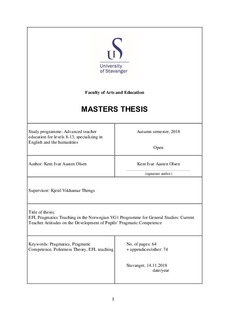| dc.description.abstract | This thesis investigates pragmatics’ current position in the first year of the Norwegian EFL programme for upper secondary general studies classes. The aim was to ascertain whether pragmatics is explicitly or implicitly taught, and whether the development of pupils’ pragmatic competence is seen as relevant among Norwegian EFL teachers. To this end, a mixed-methods approach was used through a combination of interviews with ten teachers and distribution of DCTs among 166 16-17-year-old Norwegian EFL learners. The teachers and pupils were selected from five different upper secondary schools in Rogaland, Norway. Inspired by existing pragmalinguistic research carried out by Brubæk (2012) and Norenberg (2017), the current thesis and its results can be viewed as follow-up and support of their argument for giving pragmatics and development of pragmatic competence explicit attention in Norwegian EFL instructional settings.
None of the interviewed teachers reported paying explicit attention to developing pragmatic competence in their lessons. The teachers also admitted that they were unfamiliar with the linguistic terms pragmatics and pragmatic competence. A general perception was that pragmatics receives little to no attention in Norwegian EFL classrooms. However, through teaching formal compared to informal writing, the pupils are implicitly (and unconsciously) introduced to pragmatics. Based on the interview data, other pragmatic issues, such as conventions of politeness in L2, are largely disregarded.
Data from the DCTs demonstrated that that pupils rely on L1 request formulations in L2. Native speakers of English tend to more frequently use negation and combinations of past tense and past/present progressive aspects. Only a minor fraction of the participants demonstrated native-like modification, and negation was counted only twice among the data. Instead, pupils opted for simple ‘can I/you’-formulations and external modifications, such as grounders.
The current study additionally means to contribute to and inspire further study on pragmatics’ and its position in Norwegian EFL instructional settings. To this date, the amount of research conducted on Norwegian pupils’ interlanguage pragmalinguistic performance is considerably low compared to similar research carried out internationally. As such, more research is needed to map the extent of possible lacking pragmatic competence in Norwegian EFL classrooms. | nb_NO |
